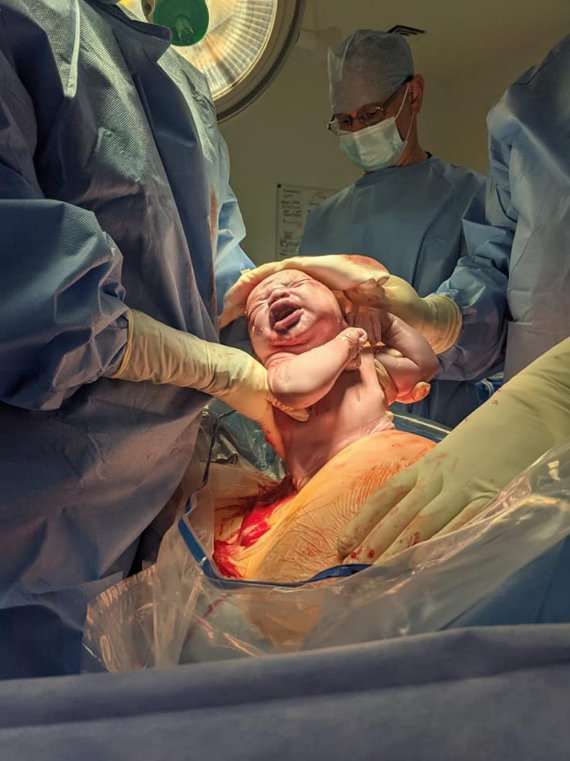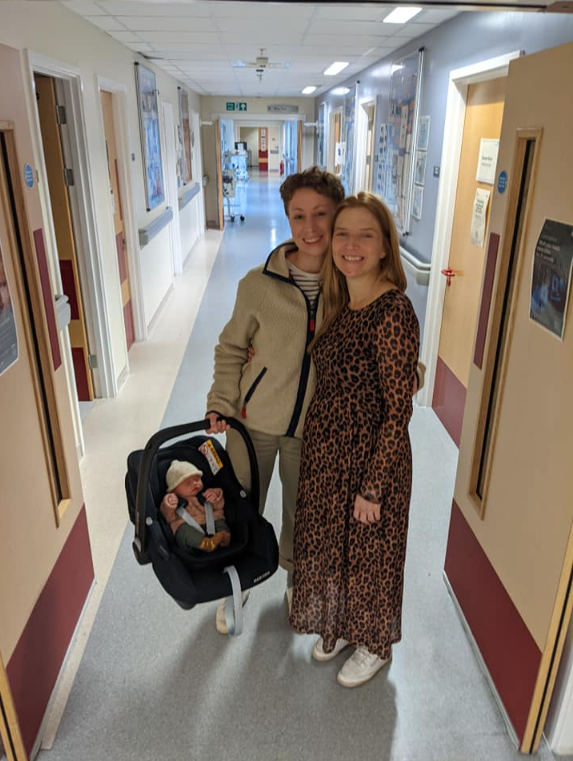
In My Story, readers share their unique, life-changing experiences. This week we hear from Kat Clarke, 42, who now lives in Australia, but gave birth in the UK aged 40.
My partner Sue and I needed fertility treatment to get pregnant – and despite the fact there is nothing wrong with me, it still took 18 months, two miscarriages and an ectopic pregnancy before we got the news we’d hoped for.
We were so ecstatic to finally be pregnant. I was blessed with the pregnancy from heaven: experiencing a teeny bit of fatigue in the first trimester, and then feeling amazing, beautiful, sexy and capable of anything.
I’m a professional acrobat and was able to keep up with some flexibility training and handstands throughout pregnancy – almost until the very end.
Throughout my pregnancy I practiced hypnobirthing using a Positive Birth Company (PBC) course and very quickly decided I wanted an unmedicated and calm water birth in a midwife-led unit. I’d always been so excited to experience natural birth.
At 38 weeks pregnant, I was transferred to the midwife-led unit – and was so excited that my dream birth was in view. Little did I know that things were about to stall...
At 41 weeks pregnant, I still hadn’t gone into labour. So, as per NHS guidelines, I had an induction booked for April 8, which I didn’t know whether to accept or not.
Sue and I went into the hospital for reduced movements on April 3. Because I’d had IVF and was 40 years old, I was told I had to go to the main hospital in Manchester. It doesn’t have a midwife-led unit, so I didn’t want to give birth there.
The consultant doctor we met there was lovely, caring and respectful, though she was pushing me for an induction the following day because of my baby’s reduced movements and being a week overdue.
I said ‘no thanks’. I wanted to have daily cardiotocography (CTG) monitoring to measure my baby’s heart rate instead – at least until my booked induction, giving him one last chance to come by himself.
But then they did a scan and found out I had almost zero waters left surrounding my baby, so things got more serious.
I was moved into the high-risk category and was told I had to give birth in hospital – no lovely midwife-led unit birth for me. I was upset but also concerned for my baby, so I accepted this. There was one birthing pool room at the hospital and my doctor said she’d try to get us in there.
They were very worried about the reduced movements, plus the waters, so asked us if we could come back for an induction that day. I discussed it with Sue, and used The Positive Birth Company’s decision-making framework (called B.R.A.I.N.) to help make an informed decision, and we agreed.
I also had my first sweep and was found to be 1cm dilated. The doctor said she could probably already break my waters now, and that it was possible I wouldn’t need multiple pessaries. This seemed good to us, so we went into it in good spirits.
We went home and came back in at 4pm (after I got Sue to dye my hair – priorities!). We had our own room and fussed around until the first pessary was inserted at about 7pm.
They stay in for six hours after which time you get examined again and see if you’ve progressed – if you haven’t, they repeat this up to four more times.
At 7pm I was still 1cm dilated; at 1am, I was still 1cm; and at 8.30am the next day, I was still at 1cm. I felt disheartened about this lack of progress, but the midwives said it was common for things to take a while.
They said they could do another pessary, but not for 24 hours (which would be 9am on Monday) and I had to be monitored, so I couldn’t go home during this time.
I said ‘no way, thanks’. Sue and I were both shattered – she was sleeping on a mat on the floor, so they suggested I should skip the fourth pessary, have my waters broken and go straight on the syntocinon drip (a drug that encourages contractions). I agreed to it, given that it was going to happen anyway. And this is where things started going off-piste.
The delivery ward was so busy that night – and with the drip, things can happen fast, so you need a delivery room to be available. But none were free.
A midwife came in and told me that there were higher-priority women coming in and that the wait for me for a delivery room would be one to two days.
I started crying and threw a wobbly, asking to speak to the original doctor. I said my baby had no fluids and that I’d fast become an emergency if we waited. She agreed and sorted me a room within 20 minutes. It just goes to show the importance of advocating for yourself.
We were so happy once we got to the delivery ward. Sue set it all up gorgeously with fairy lights, lemongrass room spray and music, and we loved our midwife team (including a male midwife – he was great).
After five attempts at cannulation, we finally got the drip in at about 9pm Sunday night, and my waters were supposedly broken by the consultant doctor. I didn’t know at the time, but she failed to break them.
I was also examined and to my dismay, I was still 1cm at 9pm. The monitoring machine said I was having contractions, but I couldn’t feel a thing.
This went on for five hours until at 2am Monday morning my midwife started to clock that maybe my waters hadn’t actually broken, so they tried again.
This time it worked, and two things happened. Firstly, my body went into a state of shock and I started uncontrollably shaking and my teeth were chattering. Then, I immediately started getting crazy surges – four or five in 10 minutes.
It felt like I’d stolen a Ferrari and gone from 0-100 in five seconds without any warm-up.
I literally could not stop shaking. I knew it was adrenaline and that it would stall labour, so I used all the hypnobirthing techniques I’d practised for so long to try to calm down.
I struggled so hard to stop the shaking, get the oxytocin flowing, and deal with the surges with just breathing and affirmations and my little TENS machine.
After three hours I couldn’t cope and asked for diamorphine (a painkiller for severe pain), which made everything better. I was so happy, and everything was calm again and labour carried on.
But you can only have that once every four hours and it had completely worn off after two, which meant the full-strength racehorse surges were back.
“I literally could not stop shaking. I knew it was adrenaline and that it would stall labour, so I used all the hypnobirthing techniques I’d practised for so long to try to calm down.”
I requested an examination at about 8.30am. And after all that I was still 1cm dilated. Seriously, what the actual feck. I was devastated. My body was just not ready to dilate.
At that point, I knew I couldn’t do it without drugs anymore, and requested an epidural. But just after the epidural was put in, an army of doctors rushed into my room – they were worried about my baby boy.
His heart rate was plummeting by half with every surge and there wasn’t enough time for him to get it back up between them.
I was very shortly told about the risks of stillbirth and informed that it was unlikely he’d make it out vaginally considering I was still only 1cm dilated, which was scary.
At this point, I agreed to a C-section. They told me it was an emergency, pushed me up the theatre queue, and my beautiful baby Jesse was born at 9.49am on Easter Monday.

The instant they showed me his squishy little face, any disappointment I might have had about my birth melted away. Nothing prepares you for how much you’re going to love your baby.
I was taken into recovery, given a tour of the placenta, and had an incredible golden hour of skin-to-skin contact with my baby boy. I could hardly believe my body had made this gorgeous, tiny human – and I’m still riding off those vibes now.
I found out later that the reason everything went pear-shaped was because I had an extremely short umbilical cord, which is why I couldn’t dilate.
As each contraction tried to push Jesse’s head down, the short cord was pulling him right back in again. And when I did the placenta tour, there were two placentas. My partner Sue told me all these details afterwards, but I was so high I forgot.
If there are any lessons to be learned here, I’d say try not to hold any fixed ideas about your birth. It will be beautiful, no matter what happens.

Kat Clark first shared her story with the Positive Birth Company (PBC). Her story has been edited for length and clarity by HuffPost UK. To take part in our My Story series, email uklife@huffpost.com.